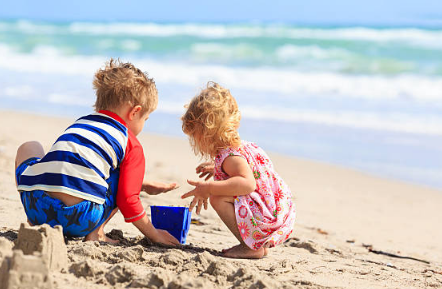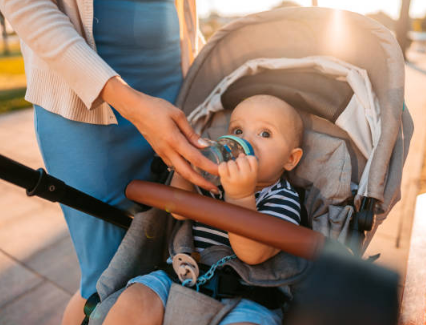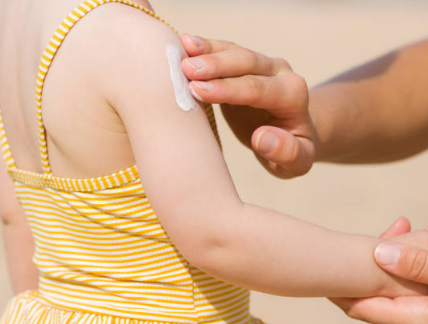Hot summers past mean carefree days lying by the pool or swimming in the lake, but as a new parent, you may find yourself more concerned about your baby’s safety in the heat. This is understandable, as hot weather can quickly become dangerous for babies. Learn more about the effects of heat on your baby’s body and how to keep your child safe during the summer months.
Risk of Overheating in the Baby
Once the temperature exceeds 80 degrees, it is difficult for the body to cool down, especially for babies. The American Academy of Pediatrics (AAP) has no official statement about babies and heat, but Jan Montague, M.D., director of pediatrics at Good Samaritan Hospital in Safin, New York, said to avoid hot weather as much as possible.
“When it’s very hot (over 80 degrees or so), you can’t take a newborn or any baby out,” she said. “Babies can’t sweat, it’s the body’s way of cooling itself, so they usually get heat stroke faster than older children or adults.” In addition, babies become dehydrated more quickly. Prickly heat is also a problem.

Overheating has also been linked to sudden infant death syndrome (SIDS), a deadly sleep disorder. “Babies sleep deeply when it’s hot, which makes it difficult for them to be woken up, which may increase the risk of sudden infant death syndrome,” explains Bruce Epstein, MD, a pediatrician in Pinellas Park, Florida.
To make sure your child stays cool and protected during the long, hot summer months, check out our expert advice.
Choose the Right Clothes
If you’re going to be staying indoors, dress your baby in loose, lightweight clothing, preferably made from natural fibers like cotton, which absorb more sweat than synthetic fibers. Good rule of thumb: “Dress your baby the way you dress”. Dr. Epstein said. “If you wear shorts and a t-shirt, that’s fine for her.”
When outdoors, wear light-colored trousers, long-sleeved shirts, and a wide-brimmed hat to cover your face. Don’t expose them to the sun on cloudy days, as harmful rays can still penetrate clouds and cause sunburn.
Provide Good Ventilation
Because babies can’t sweat effectively, they overheat faster than adults. That’s why you should never leave your baby in a hot room or parked car. Even a few minutes can cause their body temperature to spike and, in extreme cases, can be life-threatening. According to the American Academy of Pediatrics, dozens of babies and children die from heat stroke each year as a result of accidentally being left in (or climbing) in a hot car.
Also, don’t overdress your newborn for the sake of riding in the car. “Since we keep babies fairly tight and rear-facing in car seats, it can get very hot, so let them just wear a thin piece of clothing and don’t wear a hat or cover their feet – babies will transfer some heat through their feet to cool themselves and their heads,” Montague said. “Also, make sure the sun doesn’t hit the baby while driving.” You can use curtains to avoid sunburn.
Use a Baby Carrier Suitable for Summer
The combination of your body temperature and the limited space of the carrier can make the baby feel hot and upset for a few minutes. If you want to use the carrier in warm weather, choose a carrier made of lightweight nylon instead of one made of heavy fabrics like denim, and if your child’s face starts to look flushed, remove it from the carrier.
“You can help keep your baby cool by spraying his hands and feet with water or occasionally wiping them with a damp cloth,” says Dr. Montagu. “A lightweight harness made of thin material keeps him cooler than a strap made of thick, dark material.”

Keep Them Hydrated
Even if you don’t see beads of sweat dripping from your baby’s forehead, they may lose valuable fluid from sweating on a hot day. Flushing, skin that feels warm to the touch, shortness of breath and restlessness can be warning signs of dehydration.
Since babies under 6 months of age should not drink water (babies over 6 months of age can drink water in moderation), lost fluids can be replaced by breastfeeding more often or by giving them extra formula. In the summer, babies should drink at least 50% more water than usual (normal fluid intake is at least 2 ounces per pound per day), so a 20-pound baby who typically consumes 10 ounces should provide at least 30 ounces. Also, make sure your newborn has enough wet diapers as usual.
Plan Your Time Outdoors Wisely
In the summer, the time when your baby (and you) are least fit for outdoor activities is between 10 a.m. and 2 p.m. Eric Siegel, MD, a dermatologist in Millburn, New Jersey, says that when the sun is most damaging to the skin. Plan outdoor activities before or after this peak period.
Watch for Signs of Heat Stroke
When you go out with your child, monitor them closely for signs of heat stroke. “If he overheats, he may become very irritable or irritable, or he may become very lethargic and unable to wake up to eat or drink,” Dr. Montague said.
Also, see if they blush or feel hotter than usual. “As the overheating gets worse, she may be more sleepy, she may vomit, and her skin may go from being wet to very dry,” Dr. Broad said. “She may have a fever. Babies with these symptoms need immediate medical attention.”
Find Shade
When you arrive at the beach or park, look for a protected place, such as under a tree, under an umbrella, or under a canopy. A convenient item to bring to the shore is a tent made of treated fabric, which blocks the sun’s harmful rays. Make sure it has clear mesh sides to ensure proper ventilation. Sunglasses for your child can protect their eyes and reduce glare – just make sure the label states that the lenses block at least 99% of ultraviolet (UVA and UVB) radiation.

Use Sunscreen
Since babies under 6 months of age have thin and delicate skin, try to avoid direct sunlight. But in impractical situations, such as when taking a dip in the water, make sure they wear sunscreen. The American Academy of Pediatrics now says a minimal amount of sunscreen can be applied to a baby’s exposed skin, including the face.
For infants older than 6 months, sunscreen should be used more frequently and more frequently. Reapply every two hours or when wet or sweaty. Choose a waterproof sunscreen designed for children with a sun protection factor (SPF) of at least 15. It can also be applied under clothing. “The average cotton t-shirt has an SPF of just 5,” Dr. Siegel noted.
Get Skin Soothing Ready
If babies sweat profusely in hot, humid weather, tiny red bumps may begin to gather on their neck or groin, in skin folds behind their knees, or in creases on their elbows. This is called prickly heat. To relieve prickly heat, remove sticky clothing, wear loose-fitting cotton clothing (or a simple diaper), and apply cornstarch baby powder to the affected area. Keeping them in a cool, well-ventilated room can also help relieve symptoms.
Sunburn is characterized by hot, red, swollen skin, which is painful to the touch and can cause more pain to the baby. If a child under 1 year of age has a sunburn, contact your doctor immediately. They may ask you to apply cool (rather than cold) tap water to the burned area and then apply a moisturizer. Do not puncture the blisters; They prevent infection. Your child’s pediatrician may also recommend baby products for your baby. Acetaminophen or ibuprofen are used to relieve any burn-related discomfort.
In hot weather, it’s important to keep babies cool and protected from the sun. If you have any questions or concerns about caring for your baby in the heat or are concerned that they may suffer heat stroke or sunburn, contact their doctor.
